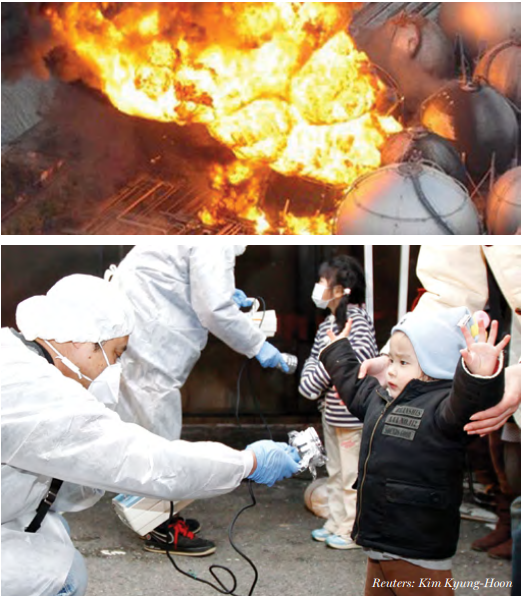Fukushima Nuclear Disaster

On March 11, 2011 a powerful earthquake and tsunami destroyed offsite power to the atomic reactor complex at Fukushima, Japan, and damaged its backup diesel generators. Without power to run the pumps, three reactors lost cooling, resulting in their fuel melting and radioactivity being released in copious amounts. Cooling to storage pools filled with intensely radioactive spent fuel failed as well, with the fuel apparently catching fire. Immense radiation doses were reported nearby and contamination spread over large areas of land and sea.
For people concerned with nuclear safety, the fear had always been of meltdown at a reactor. That three nuclear plants could be in trouble, however, is beyond comprehension. That spent fuel pools, containing multiple cores, could at the same time also lose cooling and the fuel burn, forcing into the environment much of their radioactivity is a disaster of unique proportions.
Japan is a country that knows the consequences of the unleashed atom as does no other. Nuclear fuel, melting and burning, spreading fallout far and wide must have a special terror for them.
In America, we ignored the lessons of Three Mile Island, with industry asserting the accident was an anomaly from which they had learned. We ignored the lessons of Chernobyl, with nuclear advocates claiming “it can’t happen here.” But now this disaster in Japan, a technologically advanced society using reactors built by GE, identical to 23 we have running here, makes that industry mantra untenable. It is time to pull the plug on this disastrously dangerous technology.
All U.S. reactors also need offsite power to run the cooling pumps. If that power fails, in what is called a “station blackout” accident, backup diesel generators have to work. They didn’t at Fukushima, and they could fail here.
For four years, for example, the San Onofre nuclear plant ran with batteries that are designed to startup the diesel generators that weren’t properly connected. Four years! A couple of years later one of the diesels failed to start; because the other one was down for repairs, the reactor had no functioning backup diesel generators. A couple of years ago it was revealed that a worker at San Onofre had fabricated—for five years—hourly fire watch logs, recording fire watches that never occurred. The fire watches were supposed to compensate for San Onofre’s refusal to fix dangerous flammable electrical cables that never got fixed; a fire could take out the control wires and thus control—and cooling—of the reactor could be lost.
For eighteen months, the Diablo Canyon nuclear plant ran with key parts of its emergency core cooling system disabled, without the operators even realizing it. The plant was built initially to withstand a much smaller earthquake than eventually was shown to be possible at the site when a new fault, the Hosgri, was discovered. Three years ago an additional fault, the Shoreline, was discovered, that may intersect with the Hosgri Fault and result in an even larger quake than that for which Diablo was designed.
Nuclear plants contain one thousand times the long-lived radioactivity of the Hiroshima bomb; their spent fuel pools contain some multiple of that, several Chernobyl’s worth. For that radioactivity to stay out of the environment, the fuel needs to be constantly cooled, even after the reactor’s fission reaction has been shut down.
In the early 1980s, the Nuclear Regulatory Commission estimated that a meltdown at San Onofre could result in 130,000 immediate deaths, 300,000 cancers, and 600,000 genetic effects, for about a million killed and injured. There are huge amounts of radioactivity inside these reactors and spent fuel pools, and one can’t ever permit it to escape.
The Japanese tragedy should be a wake-up call. This is simply too dangerous a technology to tolerate. It proliferates nuclear weapons; produces highly radioactive wastes dangerous for hundreds of thousands of years, for which no safe disposal method exists; is a target for terrorists; is uneconomical; and, as now shown in stark relief once again, poses an unacceptable risk of accident. It is time to “bridge the gap” between our current reliance on this unacceptably dangerous power source and a safe, renewable energy future.
Bridge the Gap continues that fight. We need to learn the lessons Fukushima so painfully teaches, and turn to a safer path.